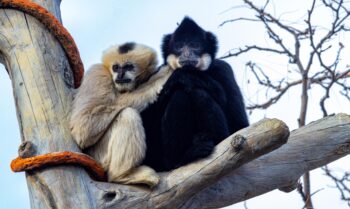May 17, 2019
Mischievous Milford
One Very Curious, Intelligent Bird Might Just Be Denver Zoo’s Best-Kept Secret
By Jessica Meehan
Every once in a while, you come across a new animal that makes you feel like you discovered the best-kept secret at the Zoo—an animal that observes you with its intelligent eyes as much as you observe it. If you’ve ever wandered behind Bird World, you probably know exactly which animal I’m talking about. Milford, our ever-curious young kea, a large parrot species native to New Zealand, is likely to come up to give you a closer look in the habitat he shares with his mom, Anna, and dad, Sorento. You can tell him apart from his parents by the yellow color around his beak and eyes, as well as his mischievous nature. Read on to learn more about Milford’s story:
From Hatchling to Habitat
Milford hatched in February 2018 and was hand-reared by bird staff at our Avian Propagation Center. Hatching and rearing kea hasn’t been easy; Milford is only the second kea to be reared at Denver Zoo. For the past several years, Anna and Sorento were either not producing eggs or breaking them part way through incubation. Our team knew we had to step in to help this pair be successful so they could contribute to the population of kea in North American zoos. In 2017, we finally hatched our first kea egg in artificial incubation and hand-reared Scarlet at the Avian Propagation Center.
Our staff did the same for Milford. For four months, we played the role of Milford’s parents, feeding and caring for him until it was time to join his family on exhibit. However, last June, as we were getting ready to introduce Milford to his parents, his care team noticed something wasn’t right. He wasn’t as active as he had been and didn’t eat all his dinner. And from there, things got worse! He started regurgitating his formula and couldn’t keep anything down. Vets responded immediately, started him on medications, and he was back to himself in a few days. After a two-week course of medication, Milford was cleared to start his introductions to his parents again and a few weeks later he was horsing around the kea exhibit driving them crazy as a young kea should.
All Eyes on Milford
Even when you think you know a species after working with them for 10 years, you’ll find that individuals will throw you for a loop. When our first kea fledgling Scarlet lived with her parents, she was an independent bird, exploring the exhibit and weaning off parent feedings quickly. By the next breeding season (beginning in December), Anna and Sorento were back to breeding and nesting. Milford, on the other hand, couldn’t be more different than big sister Scarlet. Even though he’s more than a year old, he still enjoys being fed by his parents, and demands much more of their attention. As animal care staff, we can’t be sure, but we suspect that Milford’s attachment to his parents is why they didn’t lay any eggs this year. Whether or not this was the case, all the information we gather through working with our birds is carefully recorded and collected so zoos can breed kea more successfully in the future.
Spreading His Wings
Just as a yearling kea would in the wild, we will help Milford leave his home territory to explore new adventures and meet a mate of his own! The Kea Species Survival Plan (SSP) has provided a recommendation for him that takes into account his genetic lineage and relationship to other birds in the population. Milford will be headed to Tracy Aviary at the end of May to give his parents a chance to nest again next breeding season. The kea habitat will be a little quieter without Milford, but we’re excited for him to spread his brightly colored wings!
Subscribe
Be among the first to hear the latest animal updates, important stories and details about all the fun happening around Denver Zoo.
Tags
-
 April 15, 2024
April 15, 2024Good Luck, Chuck!
Good Luck, Chuck! Beloved Bachelor Relocating as Part of Asian Elephant Species Survival Plan In a heartfelt and collaborative…
-
 April 15, 2024
April 15, 2024African Impact
African Impact Two New African Field Conservation ProgramsAim to Protect Gorillas + Grey Crowned Cranes We're honored to provide…
-
 March 1, 2024
March 1, 2024Last Place(s) on Earth
Last Place(s) on Earth New Asian Field Conservation Programs Protect Asian Elephants, Sumatran Orangutans + more Indonesia's Leuser Ecosystem…

